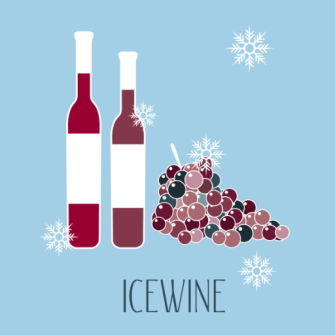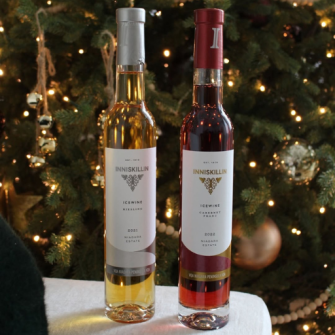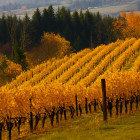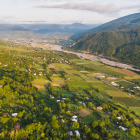
Frozen Gold: How Icewine Sparked Canadian Wine Tourism
In the heart of a Canadian winter, when the vineyard landscape of Niagara appears dormant and silent, a crucial annual drama unfolds. Under the stark, cold light of a mid-winter moon, harvesters move through rows of vines, picking grapes that are frozen solid. This is the genesis of icewine, a liquid gem that is as much a feat of human endurance as it is of winemaking.
But what is Icewine?
It is a concentrated, naturally sweet wine made from grapes left on the vine until temperatures drop to at least –8°C, causing them to freeze solid. Pressing them in this state yields only a few drops of intensely rich juice, producing a wine known for its luminous sweetness, vibrant acidity, and remarkable aromatic depth.
At the centre of this story is Inniskillin Wines, a pioneer that did not merely create a celebrated dessert wine but strategically leveraged it to become a powerful engine for wine tourism and an unexpected, yet formidable, player in the global fine wine investment scene.
From Viticultural Gamble to Tourist Pilgrimage
Before Inniskillin’s rise, Canadian wine tourism was virtually non-existent.
The country’s wine identity was unformed, and there were few destinations that could draw international oenophiles. The founding of Inniskillin in 1975 by Donald Ziraldo and Karl Kaiser was a declaration of intent. Their breakthrough came with the commercial release of their first Vidal icewine in 1984, but the true turning point was its stunning victory at Vinexpo in Bordeaux in 1991.
Overnight, Inniskillin and Canada became a presence on the global wine map.
This international acclaim not only generated sales but also created a powerful "destination brand." Curiosity about this award-winning wine from a cold climate began to draw visitors to its source.
Inniskillin astutely capitalised on this by transforming its Niagara-on-the-Lake estate into a cornerstone of the Canadian tourism experience. The winery evolved not just into a production facility, but also a cultural attraction.
They didn't just open their doors to tourists; they had a real game plan:
1

The Icewine Festival
Inniskillin became a central pillar of Niagara's annual Icewine Festival. This month-long event, held each January, transforms the harsh winter into a unique selling point. Visitors can experience outdoor ice bars, gourmet food pairings, and the rare opportunity to taste icewine directly in the frozen vineyards where its grapes are grown. This event creates a compelling reason to visit Canada in the off-season, directly boosting local economies.
2

The Sensory Experience
Tours of the Inniskillin estate are carefully curated to demystify the icewine-making process. Visitors see the frozen clusters still on the vine (in season), learn about the risky harvest, and ultimately, taste the result. This narrative, from frozen hardship to luxurious nectar, creates a powerful emotional connection that transcends a simple tasting. It turns a bottle of wine into a souvenir of a story.
3

The Luxury Ecosystem
Recognising that icewine is a luxury product, Inniskillin and the surrounding region fostered a complementary luxury tourism ecosystem. High-end restaurants feature icewine pairings on tasting menus, local spas offer icewine-themed treatments, and hotels create exclusive packages. The presence of Inniskillin elevated the entire region's offering, positioning Niagara as a sophisticated culinary destination rather than just a scenic day trip.
This model was so successful that it was replicated in British Columbia's Okanagan Valley, with Inniskillin’s estate there becoming another major draw. The winery effectively created a "pilgrimage" model for Canadian wine, in which visitors travel specifically to experience the origins of this world-renowned product.
From Cellar Staple to Investment Asset: The Unlikely Rise of Liquid Gold
While tourism addresses the experiential side, Inniskillin icewine’s integration into the fine wine investment category is a more complex and fascinating evolution. Fine wine as an alternative asset class has traditionally been dominated by Bordeaux, Burgundy, and prestige cuvée Champagnes.
For a Canadian sweet wine to break into this arena, it required a perfect storm of rarity, brand power, and market dynamics. Inniskillin icewine possesses several key attributes that make it a compelling investment-grade asset:
- Extreme Scarcity & Vintage Variation
The production of icewine is a high-risk gamble against nature. Not every year produces a viable harvest, and even when it does, the yield is infinitesimal, often just one drop of juice per grape. This inherent scarcity is the foundation of its value. Unlike a Champagne house that can produce millions of bottles annually, the supply of any given Inniskillin icewine vintage is severely limited and inherently variable, creating a classic supply-demand tension. - Proven Ageability
A common misconception is that sweet wines cannot age. Inniskillin has demonstrably proven the opposite. Well-cellared vintages of its Riesling and Vidal icewines can evolve for decades, developing complex notes of maple, toasted almond, and dried apricot. This longevity is a non-negotiable requirement for a wine intended for appreciation, both in the palate and the portfolio. - Global Brand Recognition & Legitimacy
The Vinexpo victory provided an indelible stamp of quality that resonates deeply in key Asian markets, particularly China and Japan. In these cultures, where gifting luxury items is deeply embedded, Inniskillin icewine became a status symbol. Its distinctive, elegant bottle is instantly recognisable. This global demand, especially from a market with a growing appetite for alternative investments, creates a robust secondary market.
The Rise of the "New World" Portfolio: As investors seek diversification beyond traditional French estates, the focus has shifted to iconic New World wines. Penfolds Grange from Australia and Screaming Eagle from California paved the way. Inniskillin icewine has carved out a unique niche as the undisputed leader of this rare dessert wine category. Auction houses like Sotheby's and Christie's now regularly feature vertical collections of Inniskillin, a clear signal of its investment credibility.
The investment journey often begins with tourism. A visitor tastes a remarkable vintage at the estate, purchases a bottle, and begins to understand its story and scarcity. This can spark a collector's interest, who then seeks out older vintages at auction, thus fuelling the investment market. The two spheres, tourism and investment, are symbiotically linked, each reinforcing the prestige and desirability of the other.
A Lasting Legacy of Luxury & Leverage
Inniskillin’s genius was in understanding that its product was more than just wine; it was a narrative. The story of risk, ice, and triumph was a powerful marketing tool that could be leveraged to build an entire tourism sector and legitimise a new asset class.
The winery transformed Canada's harsh climate from a viticultural challenge into its greatest brand asset, creating an "Amber Ambassador" that attracts visitors from around the world and commands the attention of serious collectors.
Today, the sound of a frozen grape being pressed at the Inniskillin winery is not just the first step in creating a world-class dessert wine. It is the sound of a tourism economy thriving, of a hotel room being booked in January, and of a collector securing a case of liquid gold, confident in its potential to mature in both flavour and value.
Through vision and relentless quality, Inniskillin ensured that Canadian icewine is a drink, a destination, an investment, and a true national treasure forged in ice.
Related Articles

A 48-Hour Getaway in Champagne: The Ultimate Tasting Journey
By Paul Declerck

The Rise of Volcanic Wine
By Sean Wright




